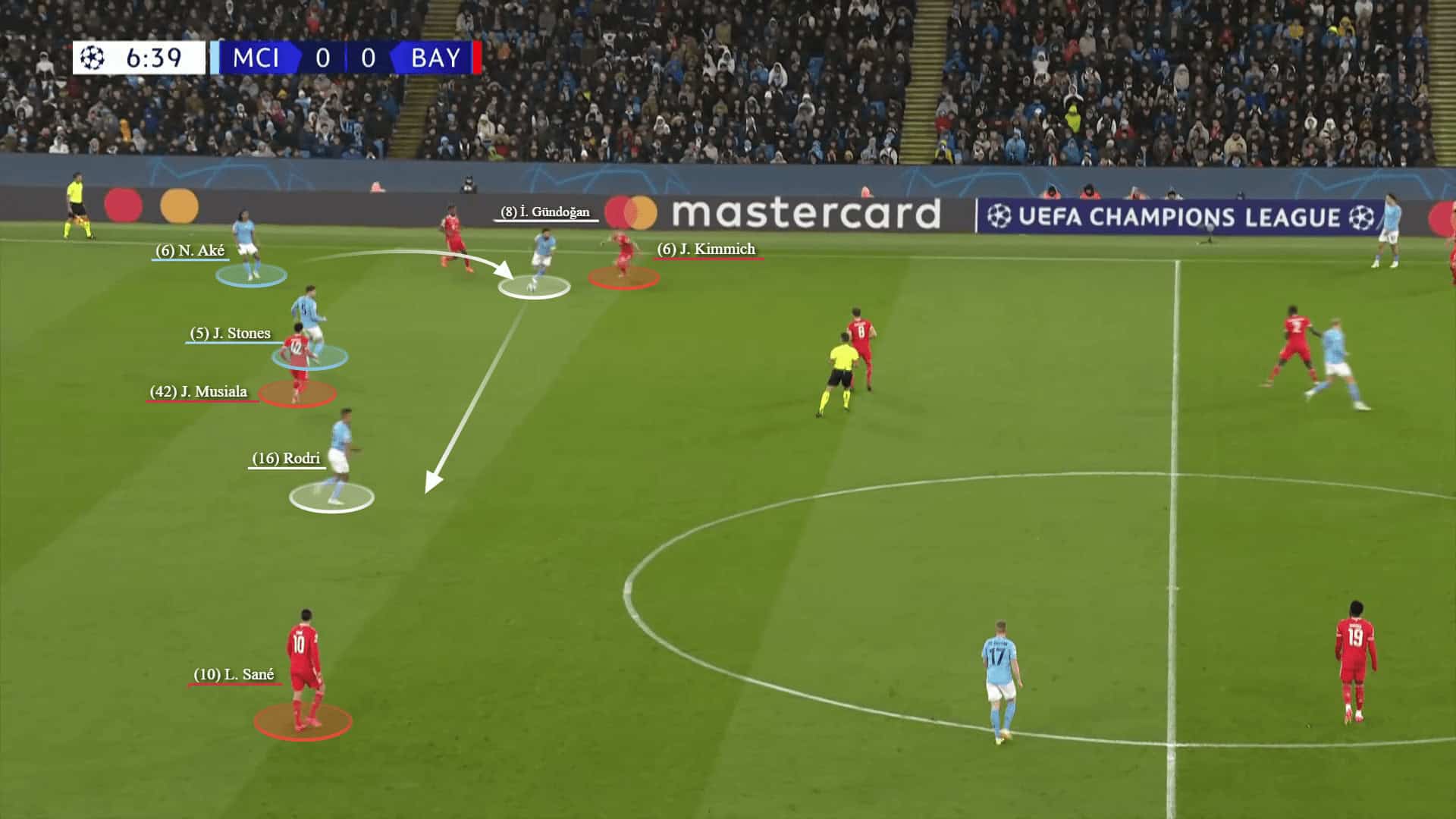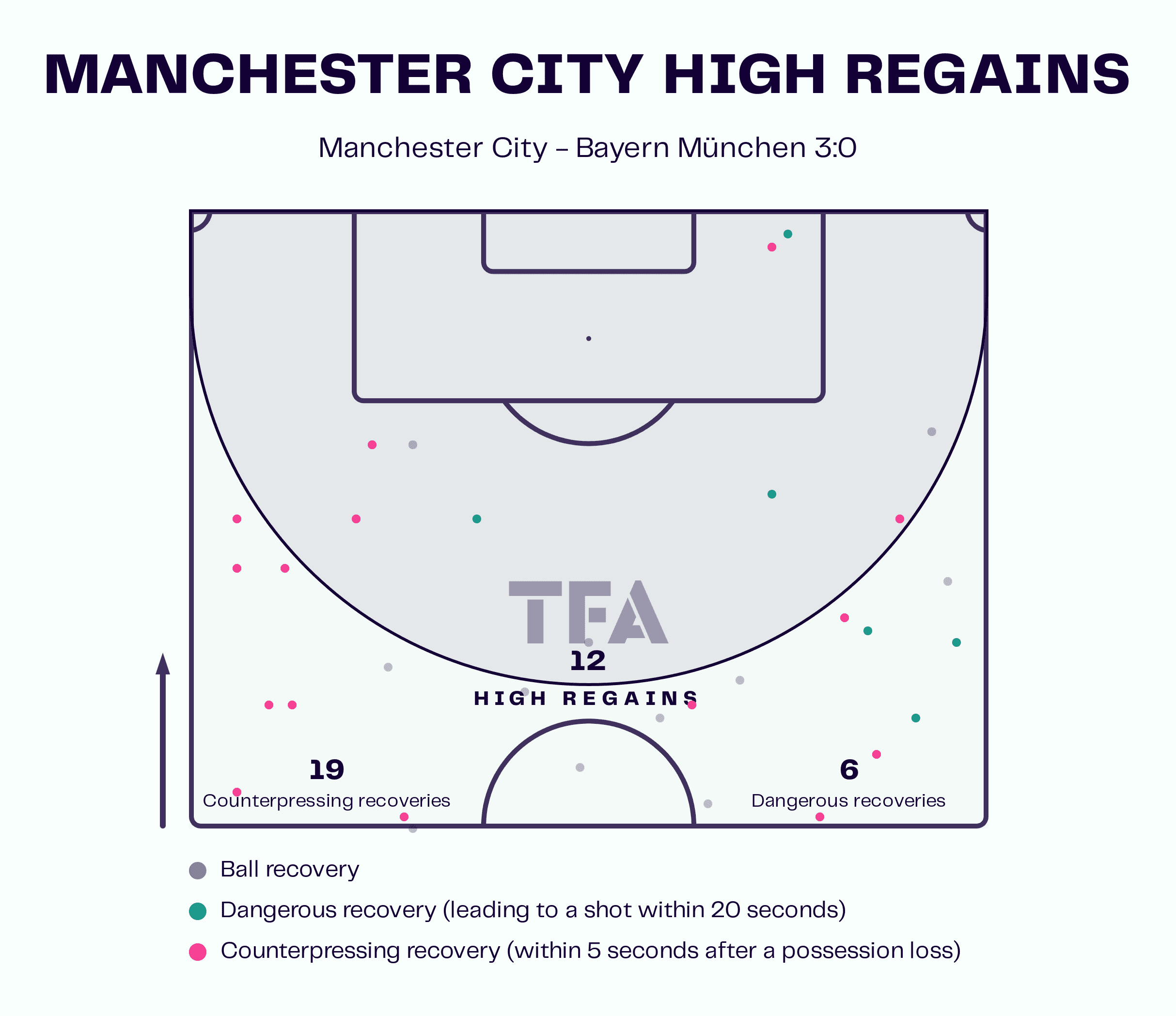A fixture between two giants is a clash of egos, where only one can emerge victorious.
Manchester City hosted Bayern Munich at the Etihad Stadium in the first leg of the Champions League quarter-final. Man City won 3-0 and are about to reach the semi-final.
This was the fourth encounter in cup competition between managers Pep Guardiola and Thomas Tuchel. Pep came out on top after Tuchel won two of the previous three including the 2021 UEFA Champions League final.
This tactical analysis will dive into tactics that both Pep Guardiola and Thomas Tuchel attempted to execute and their reactions, as well as analysing what made Pep say: “It was not comfortable, emotionally I’m destroyed. I have 10 more years today. It was such a demanding game.”
Lineups
The Spanish coach Pep Guardiola structured his team in 3-4-2-1.
Manchester City’s starting eleven: Ederson; Akanji, Dias, Ake; Stones, Rodri, De Bruyne, Gundogan (c); Bernardo, Grealish, Haaland.
Starting with Bernardo instead of Mahrez has a defensive and offensive dimension, as he has a tendency to keep the ball and play safe in possession, and his ferocity in pressing is very important in big games like this.

On the other side, Thomas Tuchel started with a 4-2-3-1 formation.
Bayern Munich’s starting eleven: Sommer; Pavard, Upamecano, De Ligt, Davies; Kimmich, Goretzka, Musiala; Sane, Gnabry, Coman.
City’s surviving vs Bayern’s positional pressure
After relying on the box midfield form or 3-2-2-3 in-possession structure recently, Pep Guardiola’s side has often become unpressable (other than using a man-oriented press which makes the backline in vulnerable situations). It can be said that RB Leipzig’s match against Man City, specifically in the 36th minute, showed that the only way until now to press positionally is to close the depth (marking the whole box) and then set a trap on the wide zones for the winger or the drifting midfielder. This is exactly what Thomas Tuchel desired.
Usually, Man City from a deeper position on the pitch create a 4-2 base by involving Ederson because of his excellent passing range and precision, thus the wide centre-backs drift to be the fullbacks while Stones and Rodri construct the double pivot.
Thomas Tuchel, on the other hand, decided to press with a 4-2-3-1 narrow positional scheme. Gnabry actively chased on the first line while the second-line trio mediated spaces and move according to the direction of the ball to press. And also positionally, the double pivot (Kimmich and Goretzka) were responsible for De Bruyne and Gundogan.
As mentioned, the aim was to trap the wide players after forcing the play to be there. In the below graphics, while the double pivot was covered centrally, Ederson plays to Ake.

The best method is to trap in an earlier area in the builder’s half, but normally the pressor, Coman here, takes time to press. So the next pass is the aim. Below, after Grealish received the ball with a bad body shape, four players immediately press and are closing the passing lanes.

The biggest opportunity for the Bavarians came from the same attitude.
Here below, after directing the play to the flank, Kimmich did a very good tackle and succeeded to regain the ball from the drifting attacking midfielder De Bruyne.

— and then Sane cut the ball back to Musiala, yet Dias was the hero of the scene and saved a genuine goal.

However, it was not completely successful. In the below graphic, after Gundogan received the pass there from Ake, he brilliantly succeeded to make a body feint, tricking Kimmich, and then moved inside without any danger and passed to Rodri. Meanwhile, it was bad tracking from Sane.

Anyway, Man City’s double pivot tactically always attempts to stay on different heights to multiply the passing options and create triangles in little spaces for the ball holder which creates a lot of third-man combinations.
later in the same scene, Rodri switched the play to the other side to Akanji who, in the below graphic, puts Bernardo Silva in a 1v1 situation against Davies while Man City occupied the five vertical zones and have numerical superiority of 5v4 over the backline.

Thus to avoid these situations like the previous one versus their backlines, the opposition doesn’t implement man-to-man pressing considerably. Plus recently against Pep, the opponents would avoid having only +1 behind the press (5v6 with large space for the attackers).
Accordingly, teams delay and start pressing 30m away from the goal to prevent City from having this extra numerical advantage (Ederson) during this phase.
Pep Guradiola’s team there is maintaining the 3-2-2-3. Here below, while Bayern Munich keep the same 4-2-3-1, Haaland drops off to add an option but is followed by Upamecano.

Rodri and Stones are still at different heights and sometimes against this energetic narrow press, one of them drops alongside Dias which creates a flat back four and pushes Ake and Akanji wide, having time and space because Sane and Coman committed to being narrow.
These circumstances made Nathan Ake and mostly Akanji important in the progression. In the below graphic, after receiving and luring Bayern to the right side, Akanji switches the play to the weak side to Grealish. Meanwhile, Gundogan is manipulating the opposite fullback Pavard with a fake run in the half-space.

Here below, the Swiss defender plays it again but more direct to Gundogan in the half-space instead of Grealish. However, Pep is pointing to Stones, who did an intelligent escape from Musiala’s shadow, and KdB who is pointing to pass to Bernardo. Sommer takes it easily eventually.

What if he follows De Bruyne’s suggestion rather than these long diagonals? — In the below scene, Akanji passes to Bernardo who quickly delivers the ball on the same line behind Davies to the runner De Bruyn. Meanwhile, there is some bad tracking from Goretzka.

Man City still seek numerical superiority over the backline. Here below, after KdB received, they create a 3v2 on the far side.

A coincidence?
Since Haaland came to England, it seems that Pep gives him instructions to be with the ball far centre-back when City are in the final third. This pattern is generating spaces or gaps between the opposition’s centre-backs for possible deep runs from his teammates and also creates room for the Norwegian to manipulate his man (usually through double movements).
It seemed that Bayern were aware of this and Kimmich usually dropped to plug this generated space. In the below graphic, City have the ball on the flank. While De Ligt was dragged and Haaland pinned Upamecano away, Kimmich is dropping and Musiala is responsible to mark Rodri around the box.


The goal scene was exactly from the same pattern. Bernardo here plays in the depth toward Rodri who was left awkwardly by Gnabry

Musiala tried to go back quickly but Rodri was brilliant to overtake him and then scored from a curvy shot with his weak foot to make it 1-0 to the hosts.

Therefore, despite the covering error, it wasn’t a coincidence.
In the aspect of rest defence, City were superior to defend protectively against some of the best dribblers in Europe. They stayed in 3-2 and 3-1 man-to-man rest-defence shapes against Bayern’s transitions.

Bayern attempt & City respond
In contrast, while Bayern Munich used a 4-2 base during the build-up, the Cityzens appeared to implement their familiar 4-4-2 pressing scheme approach.

Firstly, Haaland and De Bruyne start actively in front and press both centre-backs while covering the shadow of both Bayern’s defensive midfielders. At the same time Rodri and Gundogan push forward to press them, and Grealish and Bernardo are closing the lanes to the fullbacks.
This approach creates a numerical parity at the backline (4v4, or 3v3 if any attacker drops off) and a space centrally to exploit dynamically.
Here, in the below graphics, Sommer plays a long ball to Pavard who moves behind Grealish. Meanwhile, Stones reacted to the dropping of Musiala.


Higher up the pitch, Man City remain with the same press, waiting for any trigger to move higher. Musiala and Gnabry are occupying both half-spaces which creates the box midfield while both wingers pin City’s backline.

Centrally, Bayern varied between 2-2 and 3-1, according to the activity of the first line. Here below, Goretzka drops between the centre-backs.

This form predominantly creates a roam for the wide centre-backs. Here below, De Ligt bypassed the first line of the press while Musiala is on the interior corridor and Sane moves inside which takes the attention of Akanji.
De Ligt plays a long ball to the overlapping Davies into the generated space behind the backline.

Bayern Munich, thanks to this and a lot of one-two and third-man combinations, kept the possession in the second half which forced Pep later to react.
In the second half, City changed their pressing to a 4-2-4 as Haaland and De Bruyne became more passive. Bernardo and Grealish were very active as they blocked passing lanes for the fullbacks and continued to press the centre-back ball carrier fiercely. Accordingly, this made Rodri and Gundogan even more passive and anxious to watch out for any possible dropping from the attackers.

Mostly this approach forced the ball toward Sommer who did not find a valuable solution except for the long ball to the last line where City had a 6v4 there.

The second goal came from this pressing. Here in the below scene, Grealish skillfully scans the situation, tries to block the passing lane to Pavard and then presses Upamecano to take the ball which ends in a goal.


Conclusion
When two giants meet, the world watches in awe.
As the tactical analysis showed, it was a great tactical match between two of the best tacticians on the planet.
Of course, the match is still on the field, and Guardiola knows this. Tuchel can win the second leg. Let us see what will happen there in Germany.





Comments